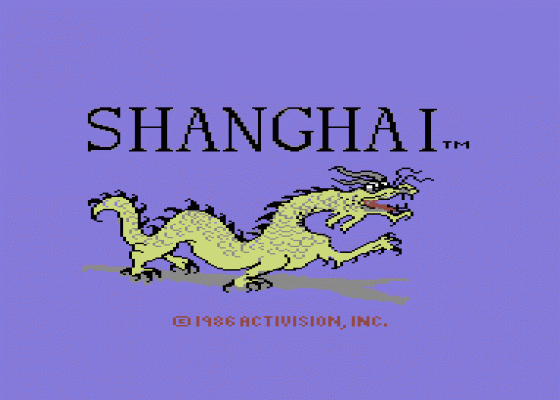
C&VG
 1st April 1987
1st April 1987
Categories: Review: Software
Publisher: Activision
Machine: Commodore 64
Published in Computer & Video Games #66
Shanghai
Based very loosely on the ancient oriental game of Mah Jongg, Shanghai is a souped up version of the old card game 'pairs' in which cards are laid face down in grid and players attempt to turn over matching pairs which are then removed from the grid.
In Shanghai the cards are replaced by tiles, as used in Mah Jongg, and the grid is replaced by the 'Dragon', a kind of 'designer pyramid' into which the 144 tiles are stacked before the start of each game. The tile at the apex of the pyramid stands on five high stack of tiles, those immediately around it are four high and so on. Only tiles at the tip of their respective stacks - 'free tiles' - can be picked up during the game.
There are three 'suits' of tiles called Dots, Bam and Crak. Each suit consists of 27 tiles, three of each number from 1-9. In addition to the suit tiles, there are twelve dragons (four white, red, and green), sixteen wind (four each of the main compass points), four seasons and four flowers.

There are four variations of the game, but in each case the rules remain the same: you can remove only identical free tiles, two at a time. The exception to the rule is found with the seasons and flowers which need not match exactly to be removed. The Dragon is viewed from above and the height of each stack is shown by lines underneath the tiles - the more lines the higher up the tile. Only the tiles on the surface of the dragon are visible so you have no idea what tile will be revealed when the one above it is removed. However, not all tiles that are visible are 'free' ones but will become as as a result of others being removed. This is where brains and future planning come in and means that a chesslike strategy of looking ahead, can be adopted.
Removing tiles is done by moving a cursor over the dragon and pointing to the first and then the second tile of the pair to be removed. A dark outline will appear around a tile to confirm your choice. If you made a legal selection, the two highlighted tiles will disappear to reveal the tiles underneath (unless either of the selected tiles was the last one in the stack), and another selection can now be made.
There are four ways to play Shanghai: Solitaire, Team effort, Tournament, and Challenge.
Solitaire is for one player only and has no time limit. A solitaire game in progress can also be saved and resumed later. The Team effort game is similar to Solitaire except that any number of players can take it in turns to remove pairs of tiles in co-operative manner. Team effort games can also be saved.
Any number of players can participate in Tournament play in which tiles as possible from an identical dragon, and the winner is the player who removes the most tiles.
In Challenge games two players take turns removing tiles from the same dragon, only this time against the clock. A player's turn is over if he removes a pair or he runs out of time. The player who has removed the most tiles at the end is the winner.
Shanghai is a game that can be played on different levels depending on how much strategy you bring into your tactics. For example, it is always advisable to remove the tiles at the tip of the highest stacks as they are blocking the most future moves. Another tip is to look carefully for a matching trio and decide which two to remove and which to leave as a potential block.
Anyone who likes board or card games, or who enjoys giving the old grey matter a touch of overtime, will not be disappointed with this one.



